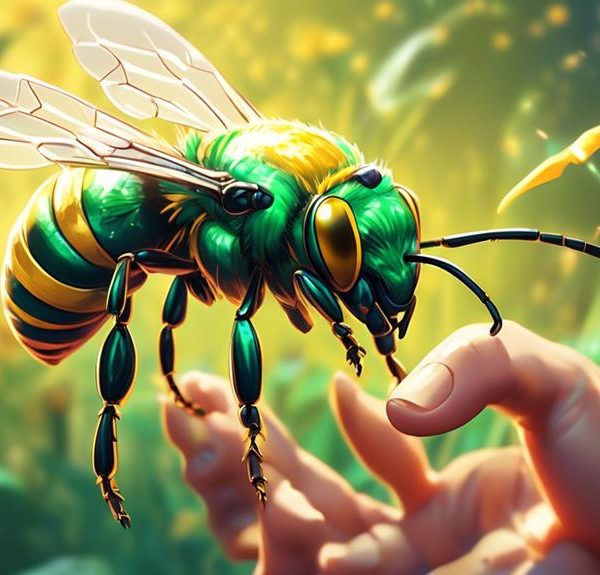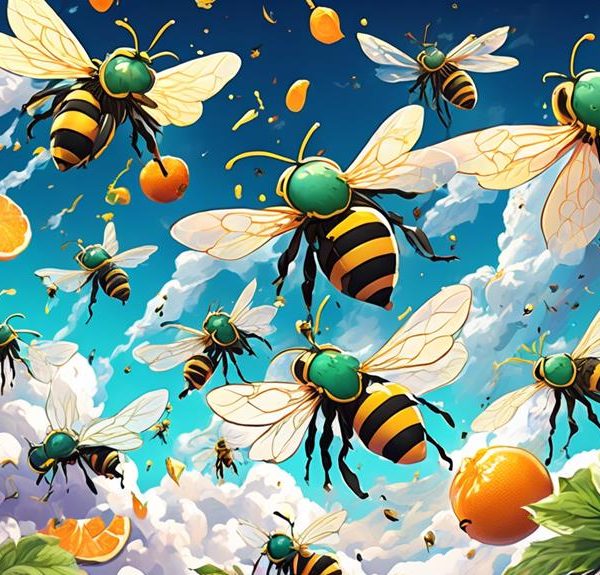Nestled underground, discover the intricate, awe-inspiring world of sweat bee nests and the secrets they hold.
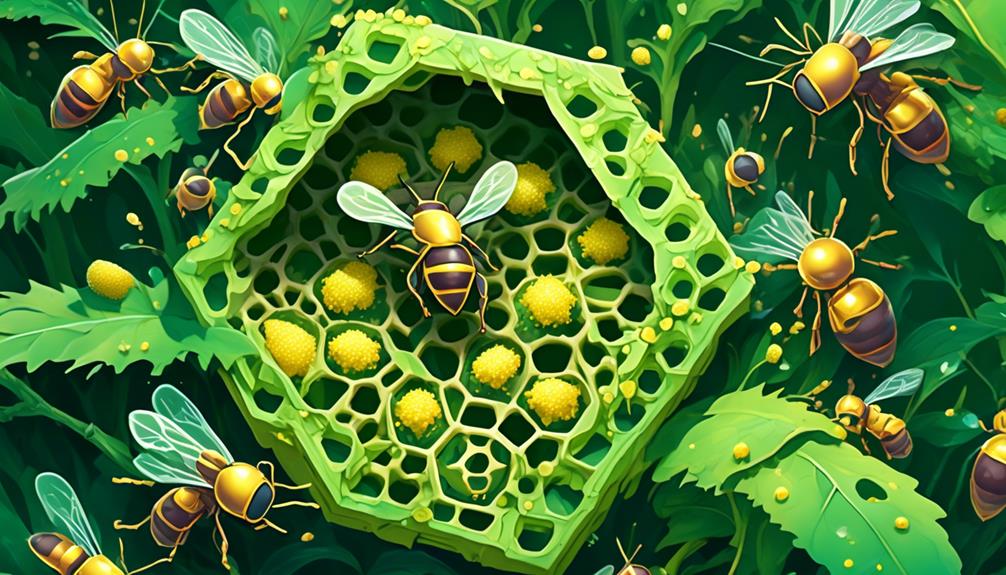
Sweat Bee Nest Description
In the bustling city streets and the serene countryside, a world of intricate architecture exists below our feet. It's your backyard's humble visitors, the sweat bees, crafting subterranean masterpieces.
These small, often metallic-hued bees erect nests that are as fascinating as they are complex. From their unique structure to their building process, the sweat bee nest is an example of nature's remarkable design prowess.
Now, wouldn't you want to uncover more about these hidden marvels?
Key Takeaways
- Sweat bees are solitary bees that construct individual nests in bare ground or thin grass.
- The nest structure consists of a vertical primary tunnel with shorter tunnels branching off to individual cells.
- The cells are sealed off to create isolated chambers for the larvae.
- Sweat bees face threats to their nests from environmental disruptions, predation, pathogens, parasites, and competition with other insects.
Understanding Sweat Bee Species
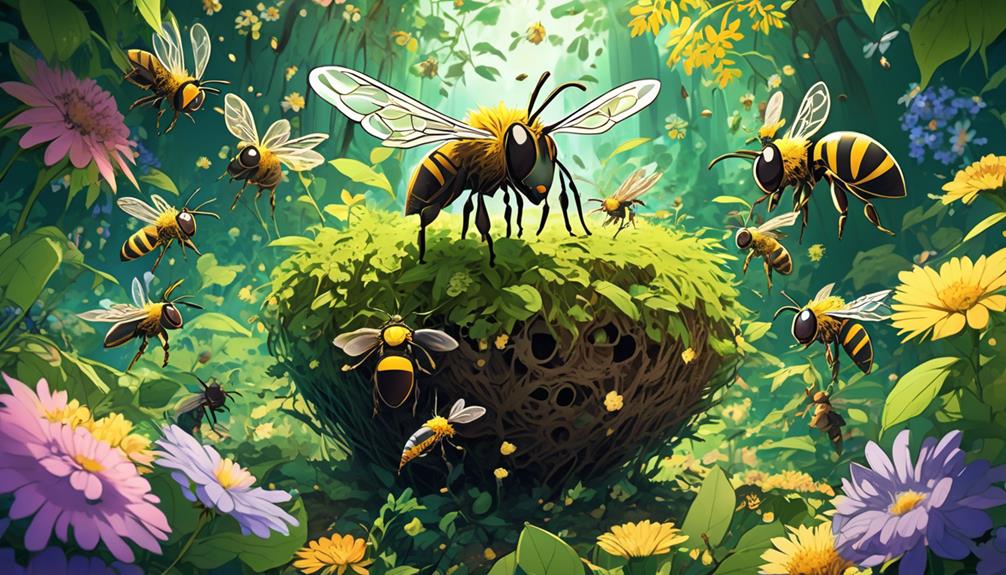
There are over 1000 species of sweat bees globally, each with unique characteristics and adaptations that make them a fascinating subject for scientific inquiry. You'll find them in diverse habitats, from open woodlands to your backyard garden. They've evolved to fill various ecological niches, showcasing the beauty of nature's adaptability.
Now, you may wonder why they're called 'sweat bees.' It's because many species are attracted to human sweat, which they consume for its salt content. But don't worry! Although they can sting, they're generally not aggressive unless provoked.
Examining their physical attributes, you'd recognize their small size, often less than a half-inch long. They exhibit a range of colors including metallic green, black, or a combination, depending on the species.
Their nests are equally intriguing. These bees are solitary creatures, with each female digging her own nest in the ground or wood, laying an egg, and provisioning it with a ball of pollen and nectar.
In understanding sweat bee species, you're looking at a broad spectrum of adaptations and behaviors, a microcosm of biodiversity. This understanding aims to highlight the importance of these often-overlooked pollinators in maintaining our ecosystems.
Sweat Bee Nest Structure
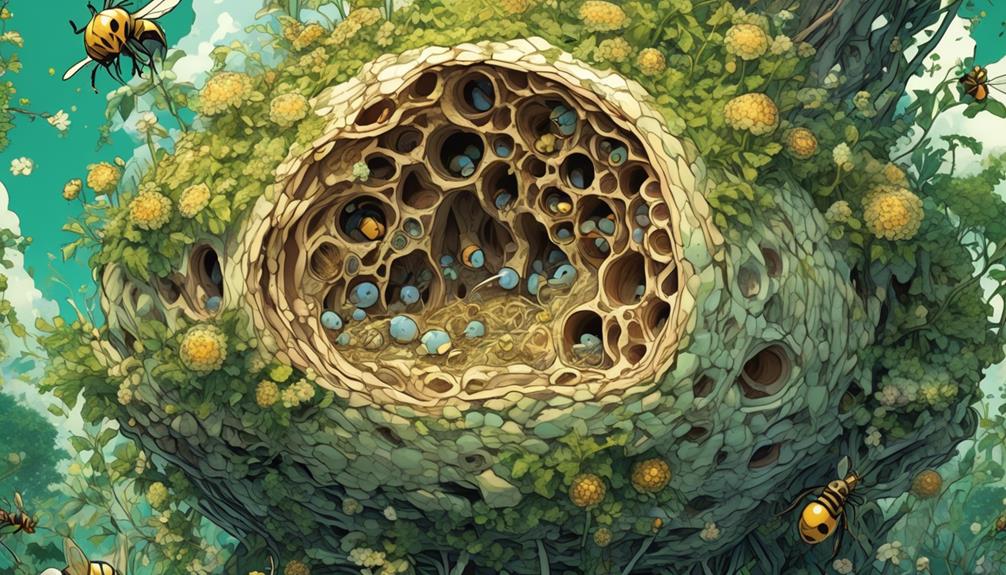
Building on our understanding of sweat bee species, let's now examine the intricate structure of their nests, a testament to their solitary and industrious nature. Sweat bees exhibit a unique nesting behavior, each female constructing her individual nest. These nests are typically found in bare ground or thin grass, with the bee preferring soft, sandy soil for easy excavation.
The nest's structure is an architectural marvel. It begins with a primary tunnel, dug vertically into the ground. Branching off from this main shaft are several shorter tunnels, each leading to an individual cell. Inside these cells, the bee stores a mixture of pollen and nectar, upon which she lays a single egg.
Each cell is then sealed off, creating an isolated chamber for the maturing larvae. Interestingly, the bees don't use any foreign material for construction. Instead, they manipulate the surrounding soil, compacting it with their mandibles to form the walls and ceilings of their nests. This ensures the nest's stability and durability.
The structure of a sweat bee's nest reflects their solitary lifestyle and incredible industriousness. Every detail, from the choice of nesting site to the construction of individual cells, illustrates their adaptiveness and resilience in a challenging environment.
Nest Building Process
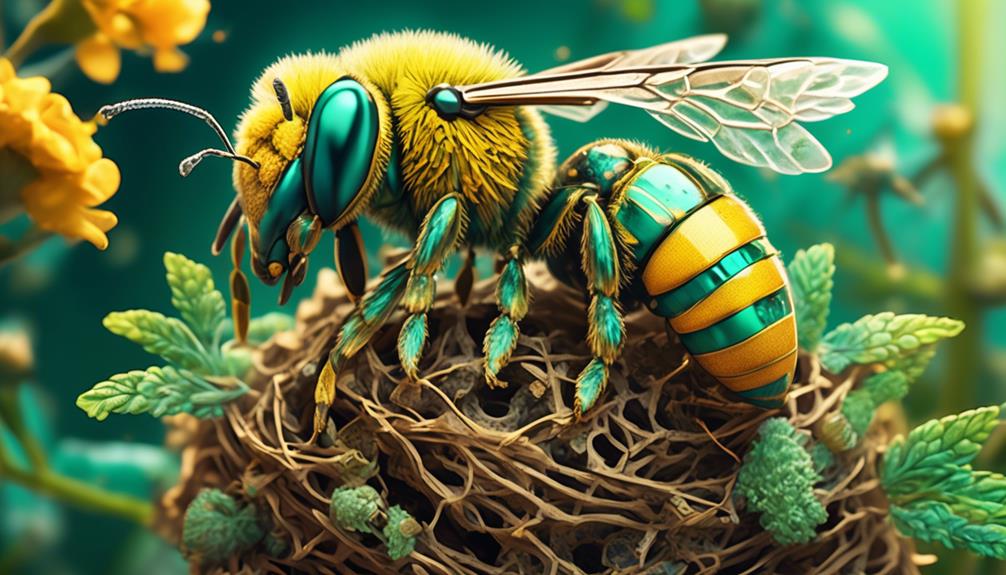
Often, you'll find a sweat bee meticulously initiating her nest construction by selecting an ideal location, typically in soft, sandy soil, and beginning the excavation of the primary tunnel. Using their powerful mandibles and forelegs, they'll dig downwards, creating a vertical shaft that serves as the main passage to the nesting cells.
This process isn't haphazard, it's a strategic operation that depends on environmental conditions and the bee's energy reserves. You'll observe that the bees tend to construct their nests during warm, dry weather when the soil is easiest to manipulate. The depth and complexity of the nest depend on the species and the individual bee's energy capacity.
The subsequent phase involves creating lateral tunnels that lead to brood cells. Each cell is meticulously crafted, with the bee moving backward, compacting the soil to form the cell walls. Once a cell is completed, the sweat bee deposits an egg, along with a food supply of nectar and pollen. The cell is then sealed with a plug of soil.
This meticulous process is repeated until the bee has constructed and provisioned enough cells to ensure the survival of her offspring.
Threats to Sweat Bee Nests

Despite their diligent construction efforts, sweat bee nests face numerous threats, ranging from environmental disruptions to predation. As you delve deeper into the world of sweat bees, you'll find that these threats are often interconnected, creating a complex web of challenges that these industrious insects must navigate.
Threats | Impacts |
|---|---|
Environmental disruptions | Human activities such as construction work can destroy the nesting ground. Changes in weather patterns, particularly extreme conditions, can also be detrimental. |
Predation | Birds, insects, and other animals may prey on sweat bees or their larvae, disrupting the nest's life cycle. |
Disease | Pathogens and parasites can infiltrate the nest, leading to high mortality rates among the bees. |
Competition | Other insects may compete with sweat bees for resources or nesting sites, which can lead to reduced survival rates. |
The survival of sweat bee nests hinges on the bees' ability to mitigate these threats. They're compelled to constantly adapt and evolve in response to these challenges. You might think of sweat bee nests as a microcosm of the broader natural world, where survival is often a matter of resilience in the face of adversity.
Role in the Ecosystem

You mightn't realize it, but sweat bees play a crucial role in our ecosystem, acting as vital pollinators for numerous plant species. They're particularly attracted to wildflowers and various types of fruits and vegetables, and their activity thus helps to facilitate the reproduction of these plants.
This pollination function is more crucial than you might think. It's not just about the survival of individual plant species; it's about the maintenance of biodiversity as a whole. By ensuring the propagation of a wide range of plants, sweat bees help to create habitats for countless animal species and foster the overall health of ecosystems.
Additionally, sweat bees' role in pollination plays a significant part in our food system. A large portion of the foods we eat – fruits, nuts, vegetables – are dependent on pollinators like sweat bees. Without them, our diets would become significantly less diverse and nutritious.
In essence, sweat bees may be small, but their impact is enormous. They're a perfect example of the interconnectedness of all life on Earth; a reminder that every creature, no matter how small, has a vital role to play in the grand scheme of things. So next time you spot a sweat bee, remember: they're more important than they seem.
Conclusion
So, you've delved into the world of sweat bees. You've understood their species, marveled at the complexity of their nests, and observed their nest-building process.
You've recognized the threats they face and acknowledged their crucial role in the ecosystem.
With this newfound knowledge, you're better equipped to appreciate these tiny, industrious creatures and perhaps even play a part in their conservation. Remember, every bee counts, even the small, sweaty ones.

